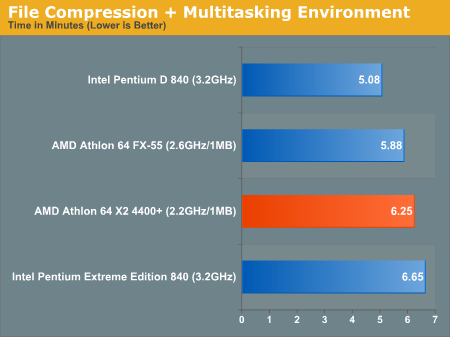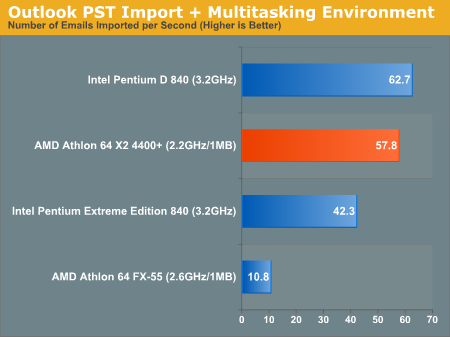AMD's dual core Opteron & Athlon 64 X2 - Server/Desktop Performance Preview
by Anand Lal Shimpi, Jason Clark & Ross Whitehead on April 21, 2005 9:25 AM EST- Posted in
- CPUs
Multitasking Scenario 2: File Compression
For our next test, we simulated what would happen if we performed two disk intensive tasks at the same time: zipping the source code to Firefox while importing a 260MB PST file into Outlook 2003. You'll note that this is a slightly modified version of the test that we originally created. We modified the test by archiving the Firefox source instead of a single smaller file; the reason being that we wanted a more realistic test (from a file size/count perspective) as well as the ability to discern better between contenders.We ran the same Firefox and iTunes tasks from the last test again, and then did the following:
1) Open Outlook.
2) Start importing 260MB PST.
3) Start WinRAR.
4) Archive Firefox source.
WinRAR remained the application in focus during this test.
Here, we looked at two metrics: how long it took WinRAR to compress our test file, and how many emails were imported into Outlook during the time that WinRAR was archiving. Let's have a look at the results:


Update: AnandTech reader manno pointed out that the metric we should be looking at here is emails imported per second while the archive task was running. Looking at these numbers, Intel actually comes out ahead with the Pentium D 840, with AMD in second place. All of the dual core chips outperform the single core Athlon 64 FX-55 by a huge margin, and once again, we see that Hyper Threading isn't always beneficial as the Extreme Edition actually runs slower than the regular Pentium D here.










144 Comments
View All Comments
Jep4444 - Thursday, April 21, 2005 - link
I don't like how you use the Opteron to give a rough estimation on the A64 X2 as their are other architectural changes between Opteron and A64That aside maybe AMD could bring out X2s using 256KB of cache per core to get slightly lower price points and atleast compete with the 830(3ghz)
I doubt it'll be too bandwidth limited given AMD is selling Semprons with only 128KB of L2 cache
KillerBob - Thursday, April 21, 2005 - link
It is usual to see that Anandtech favors the AMD, looks at the artificial tests, and not the real-world tests, where Intel wins out (as usual).In other tests itis pointed out the the PEE can be overclocked past 4GHz, in which case it'll kick everything's ass.
KillerBob - Thursday, April 21, 2005 - link
dannybin1742 - Thursday, April 21, 2005 - link
drool, i want oneDoormat - Thursday, April 21, 2005 - link
Typo P13: Intel's "975x" at bottom of page.The high price of the dual core opterons kinda puts me off. I was hoping for 2x the price of the single core, instead of 3.5x (I'm looking at 246 vs 270s). It looks like I'll be going single core (or just holding off) instead of dual core (at least until the end of the year and AMD gets price competition from Intel on the server DC front).
The 3.5x doesn't even make sense from the yield standpoint. If AMD's yeilds are 70% (wild talking-out-of-my-ass guess, no real factual grounding in picking that number), then their dual core yields will only be 49% (70% for the first core, 70% for the second core). So out of a batch of 1000 chips, instead of 700 you only get 490. Thats 210 chips you need to make up for. If opterons have a Avg selling price of $500, then the "adjusted" selling price would be around $715, an increase of 43%, not 250%. Granted, if AMD's yields are higher, the numbers look better (from our perspective - lower prices), but if their yields are less, it looks really bad (if their yield was only 50%, they'd only get 25% yield on dual core, and would have to double price).
I guess AMD is just trying to squeeze every dime they can out of this... hopefully that extra money goes to pay for Fab36 and more capacity.
cbuchach - Thursday, April 21, 2005 - link
Wow....Very impressive offering from AMD. I think the quote that sums it up best for me is: "you no longer have to make a performance decision between great overall performance or great media encoding performance, AMD delivers both with the Athlon 64 X2."I was very impressed with Intel dual core chips, but now I know that my next system will go back to be AMD-based. Overall the dual core Athlon64 should be killer.
As for cost, yes it is expensive, but the performance is really phenomenal. I am sure that it too will come down.
Griswold - Thursday, April 21, 2005 - link
All hail teh X2!bob661 - Thursday, April 21, 2005 - link
All I can say is.....WHOODOGGIE!!!!Brian23 - Thursday, April 21, 2005 - link
ME WANTY!!!jamawass - Thursday, April 21, 2005 - link
quote: Despite AMD's lead in getting dual core server/workstation CPUs out to market, Intel has very little reason to worry from a market penetration standpoint. We've seen that even with a multi-year performance advantage, it is very tough for AMD to steal any significant business away from Intel, and we expect that the same will continue to be the case with the dual core Opteron. It's unfortunate for AMD that all of their hard work will amount to very little compared to what Intel is able to ship, but that has always been reality when it comes to the AMD/Intel competition."This statement should be qualified. The Rendering market is much more adventurous than the standard server market(didn't they use winxp-64 beta running on opterons to render SWIII?) and will continue to rapidly adopt opterons.There're tangible benefits (faster rendering, lower energy costs=$$$) in moving to opteron for rendering farms. Also more oems like supermicro and broadcom have embraced AMD which should result in much more rapid market penetration than 2 yrs ago.